|
|
|
|
|
Gigabyte P67A-UD7 Motherboard |
|
Join the community - in the OCAU Forums!
|
Motherboard Features
Motherboard Features:
GIGABYTE has implemented a variety of technologies with the P67A-UD7. The core features and components include:
Ultra Durable 3 technology includes a 2oz copper design for a lower working temperature and a reduction of hotspots, better overclocking, better power efficiency allowing electric current to flow with less resistance and enabling more power efficient circuits with lower power loss and less heat generated. You'll find the majority of GIGABYTE motherboards sporting at least the 'Classic' version, where high-end models like this will up the ante even more by including Japanese solid capacitors, Driver MOSFETs and Ferrite Core Chokes alongside improved power circuitry from top to bottom.
 
SATA 3.0 6Gb/s is a native solution implemented by Intel in their Sandy Bridge chipsets, but GIGABYTE have taken it a step further by including another two SATA 3.0 6Gb/s ports (right of the white ports), joining the four SATA 2.0 (black) and two SATA 3.0 (white) ports driven by the Intel P67 chipset natively. The extra two ports are driven by Marvell's 88SE9128 controller, the same model as the controller included at the back of the motherboard for the pair of powered eSATA ports.
Due to the Intel chipset issues you may heard about in the news over the past few weeks, GIGABYTE have provided a detailed Q&A for their current and future customers, as well as a SATA Check utility to let you know which ports you have your hard drives and DVD drives plugged into, as it is recommended that customers move what drives they can to any available SATA 3.0 6Gb/s ports to reduce the chance of any issues.
 
24 Power Phase Design provides more CPU power and allows for greater overclocking margins when pushing your system to the limit. This combined with GIGABYTE's Dual-Power technology and multi-gear power saving that is adjustable via windows, allows the CPU's VRM power phases to split evenly into 2 sets of power engines that operate in tandem. This allows 1 set of power phases to rest while the other is active, as opposed to a traditional power design, where all the power phases are always active. GIGABYTE's Auto Dual Power Switching ensures that each set of phases share the power workload, effectively doubling the lifespan of the phases.
 
Power Phase LED display is an extension of GIGABYTE's Dynamic Energy Saver package that runs via Windows. The LED display gives you a visual indication of the load/usage of the power circuitry and can be easily disabled via the software if the LED lightshow isn't for you. If you choose not to utilise DES, then you'll only notice the lights show up during booting before they deactivate, before entering Windows.
Quick Access Buttons have also been included with the UD7. These include a shiny LED-lit power button, as well as the CMOS clear and Reset button. The CMOS and Reset are simple non-illuminated buttons, and while I would have loved to see them lit up like the Power button, space restrictions may have stopped GIGABYTE's engineers from placing them near the Power button in the final design.
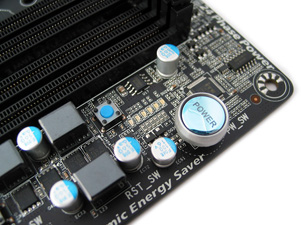 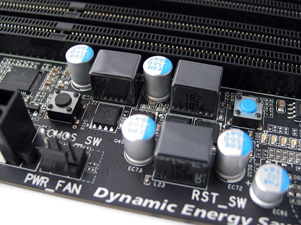
USB 3.0 Support continues to be provided by a third party NEC D720200F1 controller due to no Intel chipset offering a native USB 3.0 solution. The UD7 moves to a dual NEC chip solution linked with two VIA VLI VL810-Q8 hubs that offer four USB 3.0 connection each. This allows the UD7 to sport six USB 3.0 ports on the rear I/O panel, and another four via the two USB 3.0 front panel connectors for cases that support it.
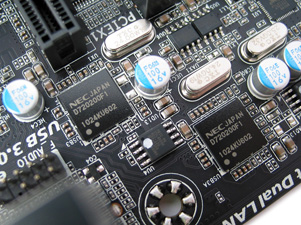 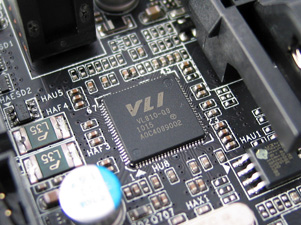
Dual Gigabit LAN is provided by a pair of Realtek RTL8111E controllers that support Wake-On-LAN, Energy Efficient Ethernet 802.3az and Teaming functionality allowing two single connections to act as one single connection for twice the transmission bandwidth.
Right next to the controllers we find Realtek's ALC889 which provides ten DAC channels that simultaneously support 7.1 sound playback, plus 2 channels of independent stereo sound output (multiple streaming) through the front panel stereo outputs - a popular choice for motherboard manufacturers.
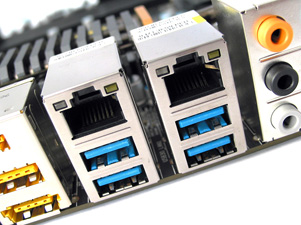 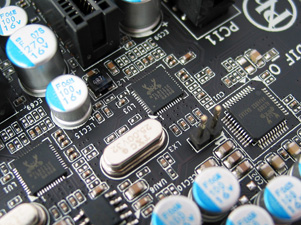
3-Way CrossfireX and SLI support is one of the key features that differentiates the UD7 from other models in the GIGABYTE range. While at first you may say 'well my motherboard has three PCI-Express x16 slots too', what you are most likely missing on your motherboard is an NF200 chip made by NVIDIA. What this chip allows is, when utilising a third video card, it maintains PCI-E 2.0 x8 bandwidth which is more than enough for any high end card on the market today. This is double the available bandwidth as compared to a motherboard without it, and while half may not sound that bad, it really does hamper performance, and that's the last thing you want when running three GPU's in one system, as no doubt you're a gamer at heart.
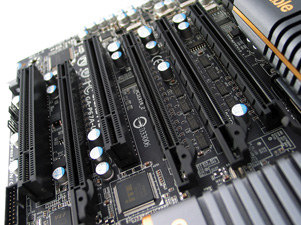 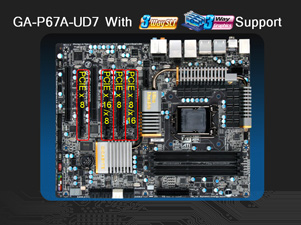
Motherboard Cooling is provided by a set of fours heatsinks linked by a nickel plated heat-pipe solution. The first two heatsinks cover key CPU power delivery circuitry, meanwhile the centre heatsink takes care of the NVIDIA NF200 PCI-E bridge chip, and the third sits on top of the Intel P67 chipset. The design of the cooling solution is ideally suited to a CPU heat-sink that pushes air towards the motherboard for optimal cooling efficiency, however while testing on a open test-bench the heatsinks were warm to touch with minimum air circulation anyway.
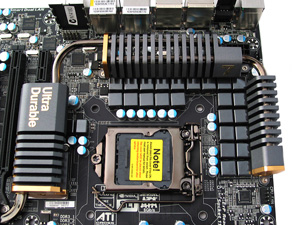 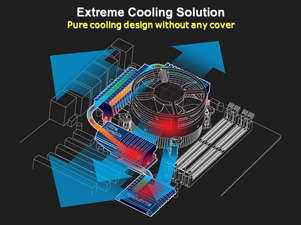
ON/OFF Charge Technology provides a set of white and red coloured USB pin headers that can easily be connected to your system's front USB 2.0 ports allowing extra amperage for your iPhone, iPod Touch, iPad to charge correctly. Unlike traditional design GIGABYTE's ON/OFF technology will allow you devices to keep charging even while your PC is off or in a variety of standby modes.
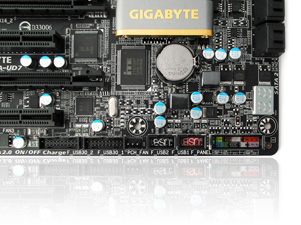 
DualBIOS - This now familiar feature includes a second BIOS chip on the motherboard. If something goes wrong during a BIOS flash the system will automatically revert to a previous version stored on the backup BIOS chip without hesitation. Not far below that we have the illuminated Debug LED panel; especially helpful during boot and system diagnostics. GIGABYTE has also been able to include 3TB+ hard drive support without the need to move to a UEFI architecture.
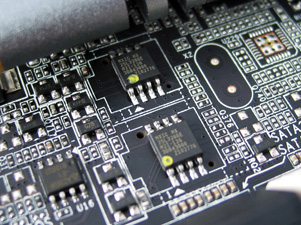 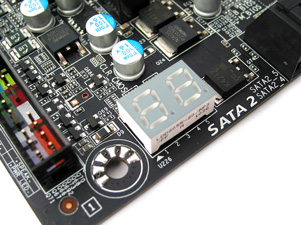
Firewire, PCI and Super I/O are provided by three independent chips. For Firewire we have the Texas Instruments TSB43AB23 an integrated 1394a-2000 OHCI PHY/link-layer controller (LLC), then across the board GIGABYTE include the popular iTE IT8728F Super I/O chip for hardware monitoring, while to the right we have iTE's IT8892 chip that provides the PCI functionality for the UD7.
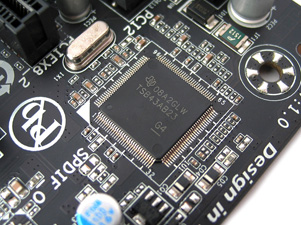 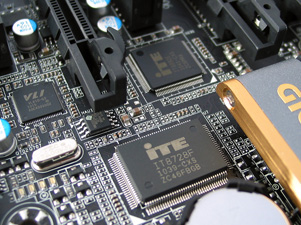
LED illumination is present in a few key areas on the motherboard, including the quick access power button and phase LED array to the left of it. A pair of green and orange indicators are also present near the ram slots and the north bridge to indicate the phase status of the CPU VTT and memory. The green LEDs light up under normal working conditions while the yellow LEDs will illuminate during overvoltage or heavy load scenarios.
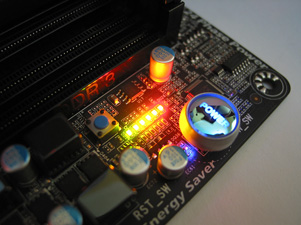 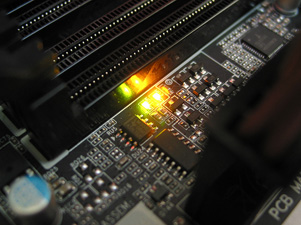
Next we have the debug panel displaying the status of your PC's boot sequence, and to the far left we have 4 embedded ACPI LEDs to indicate the system power status (S0, S1, S3, S4, S5) to prevent potential hardware damage due to improper plug/unplug actions.
But if you find all these LEDs to be a distraction, they can be disabled via the Windows based GIGABYTE Dynamic Energy Saver software. The Debug LED is constantly on, but poses minimal distraction while illuminated at night.
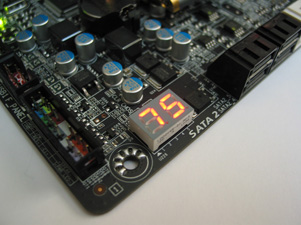 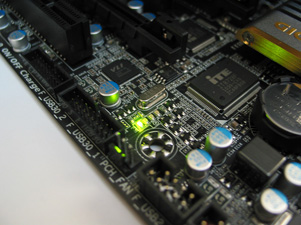
|
|
Advertisement:
All original content copyright James Rolfe.
All rights reserved. No reproduction allowed without written permission.
Interested in advertising on OCAU? Contact us for info.
|

|


